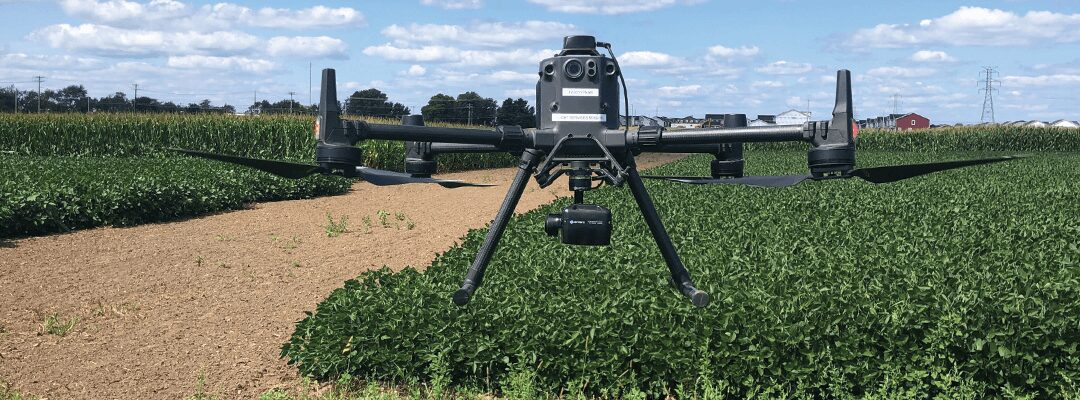Every operation poses unique needs – but do drones serve as an antidote for the majority? Today, ag drones are used for imagery, spraying, data analysis, and more; they don’t serve just one purpose for users. On the other hand, airplanes are primarily used as only sprayers; it would be more efficient to use one device to meet the operations’ demands. Once drones gain momentum in the spraying side of agriculture aviation, they have the potential to eliminate the need for ag planes of all types.
Larger aircraft still dominate the spraying side of agricultural aviation. Airplanes have been used in aerial application for agriculture for roughly a century, using research and innovation to continuously improve. From spreading seeds to spraying fertilizers, airplanes have been favored due to higher spray volume and their overall proficiency.
Whereas drones are a relatively new advancement in this field and have often been overshadowed by airplanes, especially on the sprayer side of agricultural aviation. Recently, drones have skyrocketed past planes in crop scouting and precision agriculture with their sensors, cameras, and software. These tools have assisted in exceeding ag drones’ expectations in precision, mobility, and convenience.
Whether ag drones will completely erase the need for airplanes in the industry lacks a cut-and-dry answer; however, this shift in agriculture technology shows its validity.
A Look into the History of Ag Aviation
As the agriculture industry progresses in technology, many breakthroughs have begun challenging traditional practices. When envisioning the aerial side of different fields, airplanes are usually the first to come into mind. Airplanes have been used in agriculture for roughly 100 years, whereas drones were only introduced to the industry in 2010. This is a significant difference in building a reputation and experience, which is the grounds for success in agriculture. Despite this, drone technology has begun infiltrating the ag aviation sector and proving useful in more and more aspects.
Agriculture airplanes are typically used for crop dusting, topdressing, and aerial imaging. It has proven to be a reliable and effective way of spraying pesticides, fertilizer, fungicide, water, and even spreading seeds. In past years, aerial imaging would be done using larger aircraft like planes and helicopters but has since been almost entirely replaced by drones because of their ease of use. Outside of that, airplanes have gained the confidence of more traditional agriculturists because of how long they have been used – and trusted – in the industry.
Ag Aviation: Accuracy vs. Efficiency
When it comes to efficiency, multiple factors determine which aviator is optimal for you:
- Size of operation
- Specific use case (e.g., crop scouting vs. spraying)
- Time and resources
For large-scale operations, using an airplane will be the quickest solution. Across key agricultural use cases, airplanes have several advantages over drones:
- Longer flight time
- Amount of product carried
- Overall efficiency
Of course, this varies a bit based on how you are using the drone. Let’s first look at one of the more controversial uses of drones – flying spray drones.
Today’s sprayer drone’s battery life, for instance, comes nowhere near the airtime a plane has, especially with the weight of the products it is transporting and the batteries they are carrying. This lower battery life drastically impacts the rate at which fields are being covered. By being larger, maintaining a longer flight time, and holding more product, the airplane can spray at a more rapid pace while covering a broader area. Another conflict with drone use is FAA’s regulations that could prevent spraying in certain operations.
Is quicker the best option? For some – yes – but when looking over the risks and concerns accompanying ag planes, they may overshadow the perks. Although crop dusters tend to be more efficient, they fall short of drones in the accuracy department. And, as we continue to see rising costs for herbicides and fertilizers, this may become the catalyst that pushes the development of these drones forward.
After all, drones excel in precision, which decreases risks for those directly and indirectly involved. Spraying in a more contained and accurate manner reduces exposure to chemicals, decreases costs by not using too much or wasting products, and minimizes the likelihood of contamination and drifting. This precision the drone industry has prided itself in is the primary reason they have surpassed the means of planes in the crop scouting arena. The equipment and modifications created for this purpose have given agronomic leaders faster and more reliable data on their fields.
Drones take higher-resolution photographs and collect more accurate data that allows growers to better analyze their fields, predict crop performance, assess where there needs to be an improvement, and better calculate amounts of materials needed and weather data, overall saving them time and money. And, when using a fixed-wing-drone, you can bring forward the higher endurance that airplanes offer (think more acreage with fewer batteries) without sacrificing the ease-of-use and precision. Plus, various software, like FieldAgent, has even been created to make it easy to view, report, and analyze this information.
Furthermore, drones are programmed with GPS-based, eliminating human error and ensuring it reaches all the necessary areas. Compared to manual data collection methods, you can get a complete aerial view of all acreage to truly understand performance, rather than relying on a few spot checks. (Don’t get us wrong, boots-on-the-ground scouting still has its place – but it is served better with the ability to prioritize time where drone imagery indicates problem areas.)
From smaller farms to large operations, precision ag drones are specialized in collecting the necessary data most effectively and efficiently. This variety of drones ranges in size, design, specializations, etc., all to meet the needs of the diverse agriculture industry. Ag drone technology has already advanced unbelievably in the past 12 years and will continue to grow in the future.
Extending Precision Ag Drones: Future Innovations
As years progressed, so has agriculture technology, nourishing drone technology along the way. Advancements are continuously made to drone sensors, cameras, software, and body, even dipping their wing into the spraying side of ag aviation. Once drone technology gets up to speed with carrying capacity, flight time, and aerial coverage while maintaining precision, there will not be a need or desire for ag airplanes.
Will that be tomorrow? Not likely, but it is an obtainable goal for the near future, especially as more and more companies invest time, money, and resources in drones. Continued investment in ag drone and sensor technology means technological advancements, which equates to better technology that can meet the dynamic use cases of agronomic leaders, whether in agriscience or crop production.
And, when it does happen – drones surpassing airplanes on all levels – agriculturists will be able to see a drastic decrease in costs and risks and an increase in precision and convenience.


